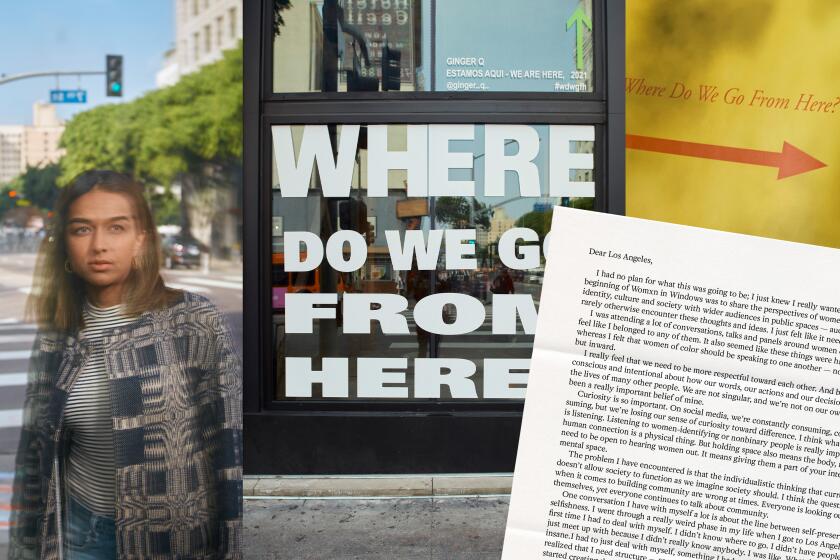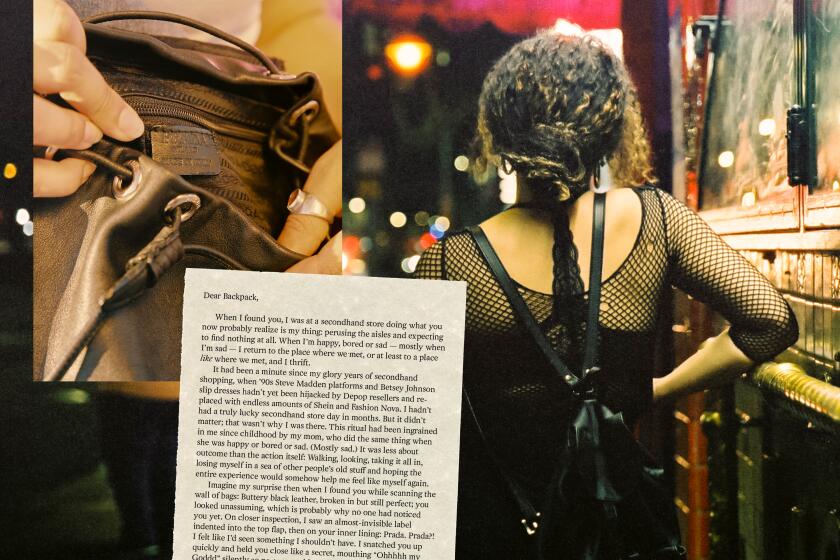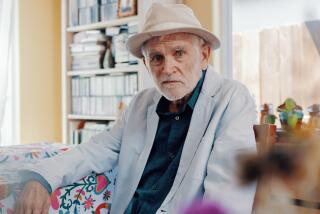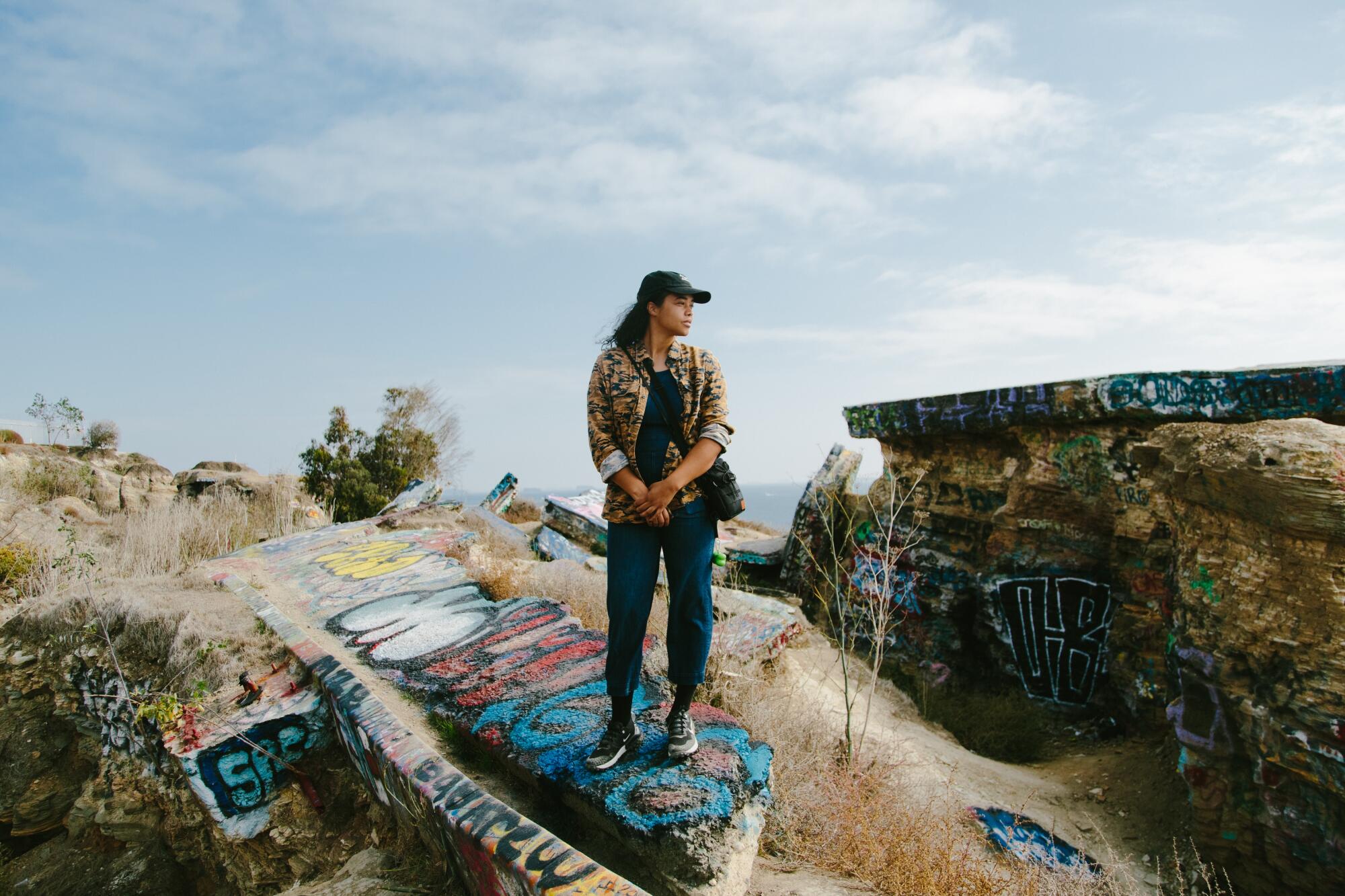
- Share via
This story is part of Image issue 7, “Survival,” a collective vision for the L.A. of our dreams. See the full package here.
To: Residents of Point Fermin Crack Area
℅ R.G. Dupuy & James L. Griffin,
leaders of petition to have the City of Los Angeles properties purchase
San Pedro, CA 90731
I’m writing to you from 2021, just less than a century after a so-called slump caused the rock layer on which your then-10-year-old homes were built to slide into the Pacific Ocean. The area looks much different. The rugged columns of land topped with cracked pavement have collapsed, and the slabs of concrete that remain are now covered with a century’s worth of graffiti writing and mural art. Discarded spray paint and beer cans fill crags in the hillside. The grass has long since dried out and died. Palm trees rise up just before where the water breaks. The ritzy neighbors you once lived beside in L.A. real estate tycoon George Huntington Peck’s exclusive tract of bungalows have been replaced with artists, daredevils and cannabis smokers. The regulars have far smaller net worths than the Broadway costumer and resident Mr. Francis B. Wheldon, or you, Mr. Dupuy, scion of a grocery company. It’s also no longer known as Point Fermin — it’s called the Sunken City.
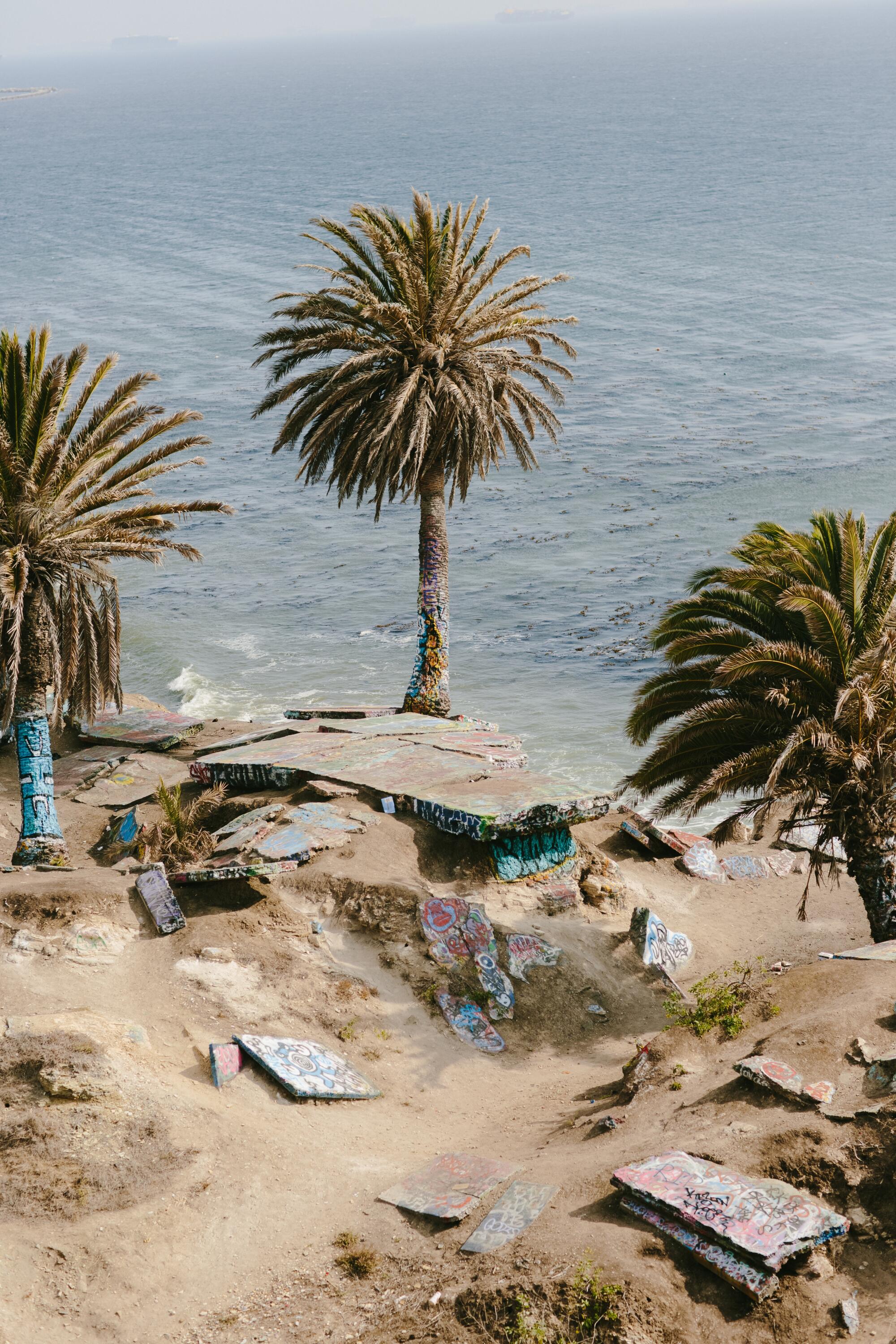
After the collapse, the remaining area was largely abandoned, aside from youth coming to revel in the ruins. By 1987 the parties had become raucous enough to persuade local authorities to install a $140,000 wrought iron fence and give authority to the Los Angeles Police Department to give tickets up to $1,000 to trespassers. It didn’t do much to stop the curious. I came here for the first time in high school with a group of friends in search of an exciting new place to smoke a water pipe. Someone’s older brother, who likely attended the parties in the 1980s, mentioned it was possible to access an old neighborhood off the coast that caved into the ocean. Back then, I felt like my life was on the brink of collapse too. And a haven was something I yearned for. I lived in a physically abusive household. My mother reminded me every day that I was a disappointment to her, although I’m still not sure about why. She even went as far as telling me to hang myself. Coming home to a place where I wasn’t wanted was less than appealing. Spending time on an unstable cliffside seemed like a great alternative.
On Jan. 2, 1929, the Earth’s crust at the southeastern tip of Point Fermin began to shift. It ruptured the water and gas lines of the Ocean View Inn. Four months later, the growing crack became visible following heavy rain. The city of Los Angeles initially insisted to the San Pedro News Pilot that there was “no cause for general alarm.” As the crack splitting Point Fermin grew, the city refilled it. The Board of Public Works eventually issued an evacuation order, and the land continued to move up to an inch per day through 1940. About 6 acres of cliffside collapsed, with two homes completely lost to the water.
These letters are part of Image issue 7, “Survival,” a collective vision for the L.A. of our dreams.
The sentiment has been similar in recent memory too. The city of L.A. has still not declared an emergency regarding our untenable and inhumane homelessness crisis, nor taken significant steps to address the causations. Climate change, aided by human behavior, worsens each year — extreme heat kills a number of Angelenos annually but the city’s housing authority refuses to install air conditioning. Locals in San Pedro have requested enforcement of fishing ordinances limiting the harvest each year but say they find their tide pools stripped and emptied. At the Sunken City, the human pursuit of happiness without responsibility has killed off the ocean ecosystems nearby.

It’s also taken lives. In 2003, two people fell from the cliffs within three days of each other, and three more perished before the end of that year. Four people died in 2006 and five in 2007, including USC football kicker Mario Danelo. In 2013, the body of a woman washed ashore under circumstances frighteningly similar to a movie about the place released the year before. It’s even been alleged that some people jump.
Oddly enough, this site of devastation and instability has become sort of a place of refuge nearly 100 years later. People wander along the cliffside to get a momentary reprieve from life’s demands and despairs. Sitting there feels like being in the eye of the storm — finding a moment of peace in the chaos. The rhythmic crest and crash of the waves rippling through the whooshes of palm leaves on the trees soothes. The painted art opens the possibility to new worlds.
Inside Issue 7: Survival
Writer Rembert Browne investigates the mysterious ailments that just showed up one day
Writer Zinzi Clemmons wants you to be able to stay in the city as long as you want
Journalist Cerise Castle pays tribute to the city’s forgotten site of refuge and devastation
Gypsy Sport designer and creative director Rio Uribe sees a future where eco-friendly won’t be slept on
Actor and activist Kendrick Sampson knows that faith and organizing infrastructure in L.A. will get us through
The Sunken City has become raw material for constructed fantasies. In the 1998 neo-noir comedy “The Big Lebowski,” the title character scatters a friend’s ashes into the ocean from the graffitied concrete. The site popped up again on the television show “Fear the Walking Dead” and again in a few novels. When I returned recently to survey the City, a crew was beginning to set up to shoot another feature film.
There is a call to open the Sunken City to the public in a naturally restored state. However, the plan has not materialized since its proposal about six years ago. City government prefers to let it sit as is. The Palos Verdes Peninsula Land Conservancy estimates that the city spends about $500,000 annually on repairs to stabilize land on an unstoppable lurch toward the ocean.
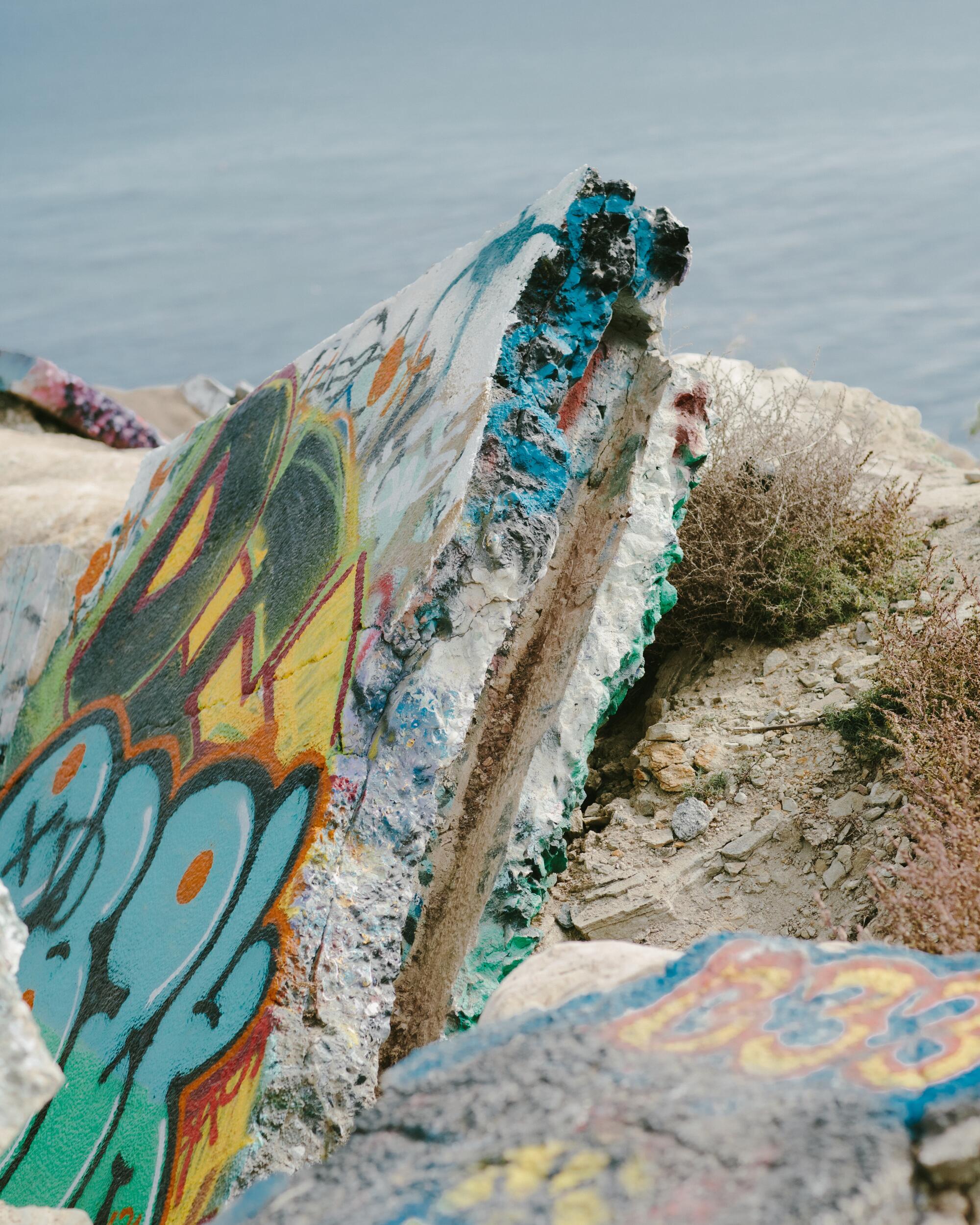
Mr. Dupuy, Mr. Griffin and other property owners: Although I write across a great expanse of time, not much has changed in our city’s approach to the ongoing slump in its most southwestern region. The nearly 100-year-old problem will continue to languish. For the time being, the Sunken City will remain as it has for the past 90-something years: a haven for those seeking escape in the face of danger. An ode to nature’s beauty and humanity’s creativity. It stands as a living reminder that this planet’s movements are beyond our control and our insatiable thirst for command over it, often at our own expense.
All my best,
Cerise Castle
Cerise Castle is a Los Angeles-based multimedia journalist specializing in arts and culture, civil rights, crime and human-interest stories. Her writing has been featured in publications including the Daily Beast and Los Angeles Magazine. Earlier this year for Knock L.A., she reported the first history of gangs inside the Los Angeles County Sheriff’s Department. In her free time, she is an avid hiker and stargazer.


